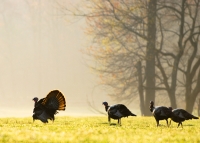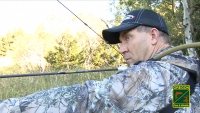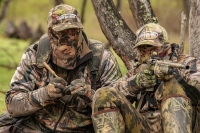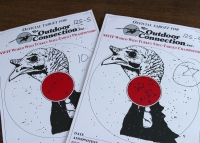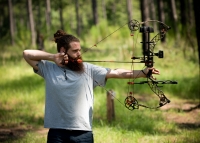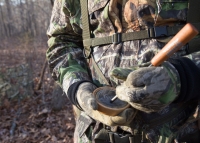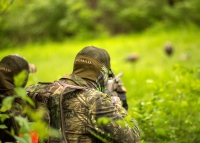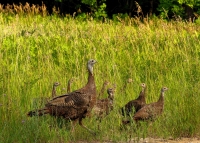
Taking the shot
Shotgun shooting tips
Turkey hunters using a shotgun face a very small target – the head and neck of a turkey. Combine that with today’s specialized turkey loads shooting very tight patterns, and making a clean kill shot might depend on a steady shooting rest.
Turkeys are nervous-looking birds that seem to never stop moving. Because of their monocular vision and eyes set on the side of their skull, turkeys are often moving and bobbing their heads to try to decipher what they’re seeing.
Consider a shooting rest
If you’ve got your gun in a ready position, and are waiting for a turkey to stop moving before you take a shot, you’ll appreciate having a steady shooting rest to help bear the weight of the gun.
Being able to support the gun in a ready position, or close to, will also minimize movement that could spook a bird.
Kinds of shooting rests for the open
If you’ve set up in front of a wide tree, you can use your knee or a pad on your knee as a gun rest. If you’ve placed your decoy 20-25 yards from your position, you should be able to predict what direction the turkey will be coming from.
Depending on the lay of the land, you may need to hunker down and lower your head to make the shot while the gun is resting on your knee. If you need to sit upright and have to lift the gun off your knee to shoot, wait until the tom’s head is out if sight, ideally behind its fanned out tail as it’s strutting by the decoy, before lifting your gun to a ready position.
Resting both elbows on both knees is stable and comfortable, but it’s hard to maintain this position and sit absolutely still.
A bipod shooting rest is another good option. Adjust the bipod to it’s the proper height for where the potential shot will come. Position the legs of the bipod ahead of the fulcrum, so the bipod actually pushes the resting shotgun toward you; this will prevent slipping and minimize gun movement.
Finally, be sure the bipod is camouflaged, as turkeys see in color.
Tripod sticks for a ground blind
If you’re hunting from a ground blind with a shotgun, consider a tripod shooting stick. A tripod shooting stick can stand on its own, so when a turkey approaches, all you have to do is put the gun on the rest and you’re ready to shoot. Some tripods are designed to hold the entire shotgun, which can help you position the gun and eliminate movement.
Be sure to get your gun in the ready position as soon as possible. The longer you wait, the closer a turkey gets and the more likely it will sense your movement, even in a blind.
Before hunting with any shooting rest, practice with it first. Know how your shooting rest works and how to adjust it. Shoot off your rest from a variety of positions, including from inside a blind.
Timing your shot
Whether you’re turkey hunting with a bow or shotgun, you’ll need to know when to take the shot. If you’re using a shotgun, the best shot will be at the head, preferably when it’s outstretched away from the bird’s body. Bowhunters will want to know something about turkey anatomy so they’ll recognize when they have a clear kill shot to a vital organ.
Make sure it’s safe to shoot
In addition to having a good shot at a bird, you’ll want to make sure there are no other hunters, livestock or other turkeys nearby that you could hit by mistake. In the spring, multiple turkeys may come to your calls and decoy. As you pick out a tom to shoot, pay attention to other turkeys that may move close to or behind it.
In the fall, turkeys often travel in large flocks that bring the birds very close to one another. Pick out a single bird shoot, and make sure you’re shot hits only one bird.
A cardinal rule of hunting safety is to be aware of what’s in front of and behind your target. In addition, the daily bag limit for both the spring and fall seasons is one bird, so killing two birds with one shot is not a legal accomplishment.
For bowhunters
When bowhunting, the closer you can get a turkey to your ground blind, the better the chance of a clean kill shot. Don’t be in a hurry to shoot at an incoming bird. Turkeys are nervous and anxious birds, likely to jump when they hear a bow string release. Let the bird approach the decoy and calm down. Once a tom starts strutting around a decoy, it’s less likely to flinch at the shot.
For shotgun hunters
Shotgun hunters also will benefit from letting a turkey chill for a bit. The more relaxed a bird is, the less it will be bobbing and moving its head (your target).
For both styles of hunting, shooting at a relaxed turkey increases the odds of hitting its small vital zone.
Shotgun hunters who get tired of waiting for a tom to break out of a strut can offer a cluck or putt call. This will often alert the tom, forcing it to lift its head and present a shot. Using a mouth call here will leave both hands free to hold your shotgun in a ready position.
Bow shooting tips
Turkey anatomy plays a big part in determining shot placement with a bow. Knowing where vital organs like the heart and lungs are will help you make a clean shot.
Sometime getting to the vital organs may mean going through bone. In fact, a shot to the spine will drop a turkey quickly. But turkey bones are very strong, despite being hollow. That’s why many experienced archers prefer shooting a bow with a heavy draw weight, often the same setup they use for deer and elk hunting.
Head shots, the most popular turkey shot for shotgun hunters, should be avoided by most bowhunters. Not only is the target very small for a bow, but the heavy broadheads created for such head shots are not the most stable in flight.
Here are some of the most common and effective shots for a turkey bowhunter to take:
- Turkey position: Standing erect, feathers tucked tight to the body, head extended and facing straight away from you.
- Best shot: This stance exposes the entire spine, from head to tail. Take advantage of this with a spine shot, one of the quickest ways to dispatch a bird.
- Turkey position: Tom in full-strut, facing straight away.
- Best shot: This position elongates the body cavity, making it possible for an arrow to slice through most of the vital organs. For the fully-fanned facing away shot, put the arrow where all the tail feathers converge, right about at the anus.
- Turkey position: Tom in full-strut, facing you.
- Best shot: Wait until the bird is standing still, then put the arrow where the featherless part of the neck meets the feathers of the chest.
- Turkey position: Standing upright, feathers tucked in, facing you.
- Best shot: Put your arrow where the beard comes out of the body for an upper heart, lower lung shot. If centered, the shot might also sever the spine. This is not a good shot if a bird is nervous and more likely to jump.
- Turkey position: Standing upright, feathers tucked in, facing broadside.
- Best shot: Follow the legs straight up the body, putting the arrow in the center of the bird’s body. This will ensure a heart shot, with the arrow traveling into an open triangular region that’s created when the bird has its wings tucked in. If you hit low on this shot, you’ll bust the femur or sever tendons, meaning the bird can’t jump to take flight. If you hit high, and are using enough poundage to break through the humerus and scapula, you’ll hit the spine and lung area.
- Turkey position: A tom is in full-strut, standing broadside.
- Best shot: This can be a tough one. The stance is deceiving because the feathers are puffed up, the head is retracted and the tail is fully fanned. This makes it hard to decipher how the skeleton is situated and where the internal organs are. The most common miss is shooting too high and hitting nothing but feathers. Avoid this by drawing an imaginary line from the base of the neck to the base of the tail. Draw a second line straight up from the legs. Shoot where the two lines intersect and you’ll have a straight shot to the heart.
- Turkey position: Quartering-to or quartering-away
- Best shot: There isn’t necessarily a good shot unless you know turkey anatomy very well and are an accomplished archer. Better to wait until the bird moves into a more accessible pose.
Practicing shot placement
Practice all you can on 3-D targets. There are 3-D turkey targets in standing, walking, and strutting positions, and all make for excellent, and realistic practice.

